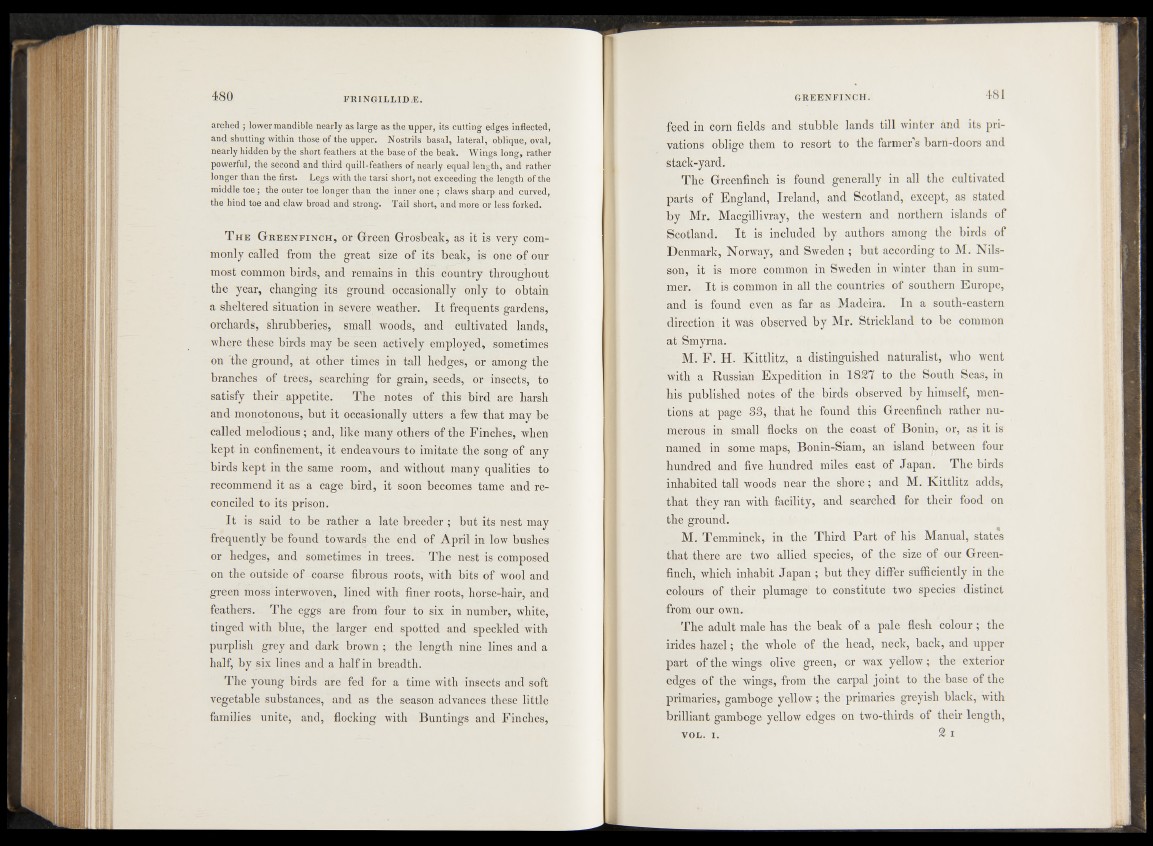
arched ; lower mandible nearly as large as the upper, its cutting edges inflected,
and shutting within those of the upper. Nostrils basal, lateral, oblique, oval,
nearly hidden by the short feathers at the base of the beak. Wings long, rather
powerful, the second and third quill-feathers of nearly equal length, and rather
longer than the first. Legs with the tarsi short, not exceeding the length of the
middle toe; the outer toe longer than the inner one ; claws sharp and curved,
the hind toe and claw broad and strong. Tail short, and more or less forked.
T he Greenfinch, or Green Grosbeak, as it is very commonly
called from the great size of its beak, is one of our
most common birds, and remains in this country throughout
the year, changing its ground occasionally only to obtain
a sheltered situation in severe weather. It frequents gardens,
orchards, shrubberies, small woods, and cultivated lands,
where these birds may be seen actively employed, sometimes
on the ground, at other times in tall hedges, or among the
branches of trees, searching for grain, seeds, or insects, to
satisfy their appetite. The notes of this bird are harsh
and monotonous, but it occasionally utters a few that may be
called melodious; and, like many others of the Finches, when
kept in confinement, it endeavours to imitate the song of any
birds kept in the same room, and without many qualities to
recommend it as a cage bird, it soon becomes tame and reconciled
to its prison.
It is said to be rather a late breeder ; but its nest may
frequently be found towards the end of April in low bushes
or hedges, and sometimes in trees. The nest is composed
on the outside of coarse fibrous roots, with bits of wool and
green moss interwoven, lined with finer roots, horse-hair, and
feathers. The eggs are from four to six in number, white,
tinged with blue, the larger end spotted and speckled with
purplish grey and dark brown ; the length nine lines and a
half, by six lines and a half in breadth.
The young birds are fed for a time with insects and soft
vegetable substances, and as the season advances these little
families unite, and, flocking with Buntings and Finches,
feed in corn fields and stubble lands till winter and its privations
oblige them to resort to the farmer’s barn-doors and
stack-yard.
The Greenfinch is found generally in all the cultivated
parts of England, Ireland, and Scotland, except, as stated
by Mr. Macgillivray, the western and northern islands of
Scotland. I t is included by authors among the birds of
Denmark, Norway, and Sweden ; but according to M. Nilsson,
it is more common in Sweden in winter than in summer.
It is common in all the countries of southern Europe,
and is found even as far as Madeira. In a south-eastern
direction it was observed by Mr. Strickland to be common
at Smyrna.
M. F. H. Kittlitz, a distinguished naturalist, who went
with a Russian Expedition in 1827 to the South Seas, in
his published notes of the birds observed by himself, mentions
at page 83, that he found this Greenfinch rather numerous
in small flocks on the coast of Bonin, or, as it is
named in some maps, Bonin-Siam, an island between four
hundred and five hundred miles east of Japan. The birds
inhabited tall woods near the shore; and M. Kittlitz adds,
that they ran with facility, and searched for their food on
the ground.
M. Temminck, in the Third Part of his Manual, states
that there are two allied species, of the size of our Greenfinch,
which inhabit Japan ; but they differ sufficiently in the
colours of their plumage to constitute two species distinct
from our own.
The adult male has the beak of a pale flesh colour; the
irides hazel; the whole of the head, neck, back, and upper
part of the wings olive green, or wax yellow; the exterior
edges of the wings, from the carpal joint to the base of the
primaries, gamboge yellow; the primaries greyish black, with
brilliant gamboge yellow edges on two-thirds of their length,
VOL. I. 2 i